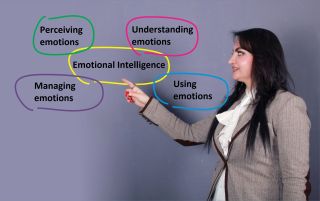Emotional Intelligence
The Value of Emotional Intelligence
There's great utility in EQ's four core skills.
Posted February 13, 2024 Reviewed by Gary Drevitch
Key points
- Emotional Intelligence is a powerful soft skill.
- EQ processes are interrelated and intertwined.
- EQ is teachable and attainable.

We live in uncertain times, when people have to be equipped with an arsenal of psychological tools and skills to be able to navigate unexpected changes, especially under the intense conditions of war.
The term emotional intelligence, or EQ, is often thought of today as a prerequisite for success. It has been defined, by Peter Salovey and John Mayer (1990), as the ability to monitor one's own emotions, as well as other people's emotions and feelings, to differentiate between emotions and label them appropriately, and to use emotional information to guide thinking abilities and external verbal and non-verbal behaviour (Rostomyan, 2022). Emotional intelligence was later refined into four proposed abilities by American psychologist Daniel Goleman in his book, Emotional Intelligence: Why it Can Matter More than IQ (1995): a) perceiving, b) understanding, c) using, and d) managing emotions.
Now let us have a closer look at these different, but correlated processes:
- Perceiving emotions. This is the ability to get emotional messages from the outside world and to detect emotions in faces, pictures, voices, and cultural artifacts. This includes not only perceiving the emotions in others but also the ability to identify one's own emotions. Perceiving emotions represents a basic and grounding aspect of emotional intelligence, as it makes all other processing of emotional information possible.
- Understanding emotions. This is the ability to comprehend emotive language and to understand the emotions in others in order to be able to preserve healthy relationships, which also presuppose emotions. For example, in the process of communication, this means trying to understand the viewpoint of the other person, his or her intentions, internal motivations, feelings, beliefs, desires, etc. (Rostomyan, 2013/2022). It also involves understanding slight variations between positive and negative emotions, and the ability to recognize and describe how emotions evolve over time in interpersonal interaction.
- Using emotions. This is the ability to deploy emotions to facilitate various cognitive activities, such as thinking and problem-solving activities. An emotionally intelligent person can capitalize fully upon his or her changing moods in order to best undertake the task at hand. Also, one can also use their own emotions to have an emotional impact on another through gestures, facial expressions, voice fluctuations, mimics, emotive words and phrases as positive and/or negative intensifiers, etc. (Rostomyan, 2013/2022).
- Managing emotions: This is the ability to regulate emotions in both ourselves and in others. The emotionally intelligent person can attune to emotions, even negative ones, and manage them to achieve intended goals. This also includes managing the expressions of emotions on the verbal and non-verbal levels for harmonious cooperation and conflict reduction (Rostomyan, 2013/2022).
All of these processes are tightly intertwined and do not exist in separation, so in our everyday lives we continually practice them while interacting with one another, and they are the groundings of our everyday emotional experiences. These soft skills have the potential to make our lives worthwhile.
References
1. Goleman, D. (1995). Emotional Intelligence. New York, Toronto, London, Sydney, Auckland: Bantam Books.
2. Rostomyan, A. (2013/2022). The Ultimate Force of Emotions in Communication: A Linguo-cognitive Analysis of Verbal and Non-verbal Expressions of Emotions (on the material of English). Dissertation. Dueren, DE: Shaker Verlag.
3. Salovey, P. & Mayer, J. (1990). Emotional Intelligence. Imagination, Cognition and Personality, 9(3), pp. 185–211.


